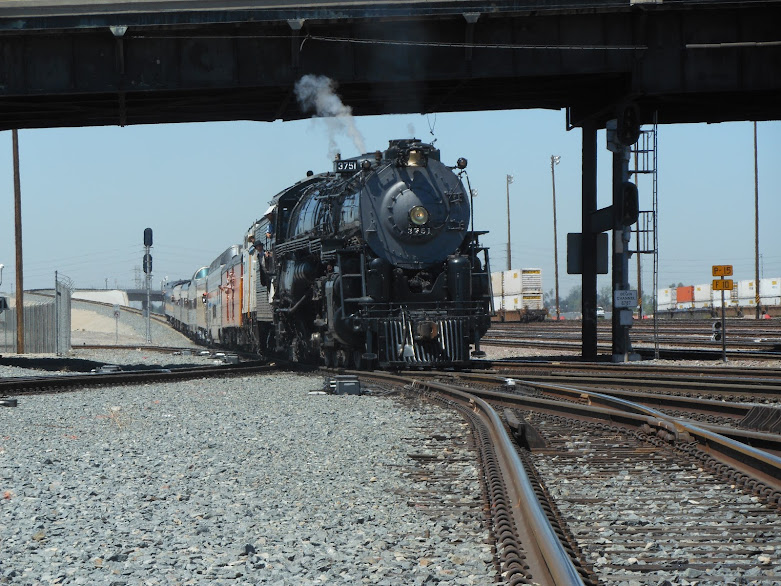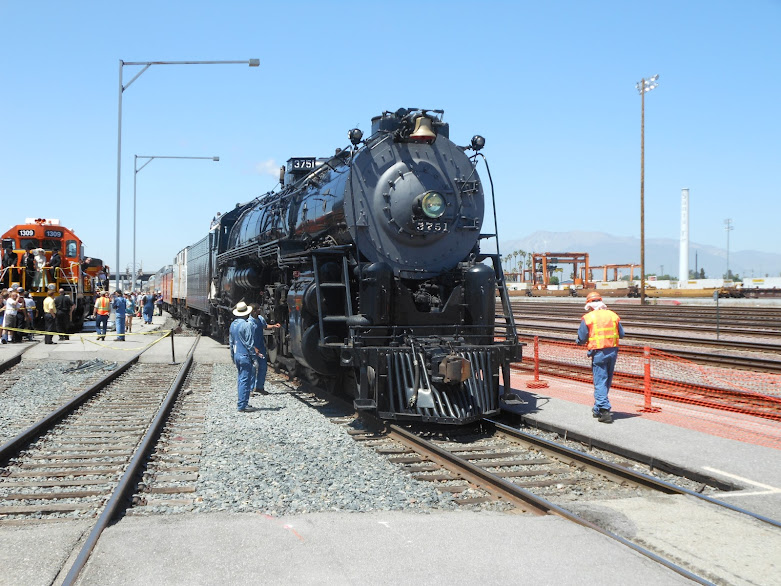As was the case in prior years the star of the San Bernardino Railraod Days (in San Bernardino, Ca) was ex Santa Fe "Northern" (4-8-4) locomotive #3751. Dozens of railroad photographers and fans alike lined the tracks in front of the cities preserved vintage passenger depot to catch a glimpse of living history. As would be expected the locomotive that was once the pride of the Santa Fe railroad steamed her way down the Metrolink trackage from her home in Los Angeles to San Bernardino in grand fashion. As the locomotive neared the station photographers climbed over each other and shutters clicked away.
Once the train had come to a complete stop an array of passengers stepped out of a group of vintage passenger cars that once made up some of the most famous trains in history including Burlington's (Route) famed Zephyr and Southern Pacific's legendary "Daylight". Many of these patrons wore turn of the century attire .... or even a cowboy costume or two, which added to the general fun atmosphere of the event.
Photographers took full advantage of having a classic steam locomotive parked right in front of them ... well that is until the blazing California sun became too much and afternoon temperatures soared into the nineties. At that point even the most hardy rail geek had headed for the shade and a large amount of aqua.
As most of you probably already know locomotive 3751 spent a good portion of her retirement on display across the parking lot from this very same depot as a static display so whenever the old gal gets a chance to come home it's a special treat indeed.
History:
The AT&SF paid Baldwin Locomotive Works $ 99,712.77 for No. 3751, the thirteenth 4-8-4 of 892 constructed between 1926 and 1950 for U.S. railroads. A joint design effort of Santa Fe Mechanical Engineer Howard H. Lanning, his staff, and Baldwin, Santa Fe's first 4-8-4 was a mixture of conservative design and the best locomotive technology of that time. Boiler pressure was set at only 210 pounds, even though many engines had been set at 250 pounds since 1917. Modern features included cast steel cylinders keyed to the engine bed, front-end American multiple throttle, Elesco feedwater heater, Duplex stoker, Nicholson thermic siphons in the firebox, which had a large grate of 108 square feet, and the Type E high-temperature superheater.
No. 3751 entered into passenger service on this difficult New Mexico division, with grades of 3.5 percent westbound and 3.3 percent grades eastbound over Raton Mountain (where 2-10-2 helpers were employed). Performance as compared to the 4-8-2s was so marked that Santa Fe ordered nine additional 4-8-4s, Nos. 3752-3760, which were delivered in early 1928; four more, Nos. 3761-3764 followed in 1929.
The May 1936 inauguration of the diesel-powered Super Chief and the need for relief steam power put No. 3751 in the San Bernardino shop for conversion to burn oil, which was completed in December. A 5,071 gallon oil tank was fabricated for the coal compartment in the tender, and the engine was assigned to operate between Winslow and Los Angeles. On the days the weekly Super Chief operated, No. 3751 was held at one intermediate engine terminal for possible relief. Through engine runs were established between La Junta and Los Angeles effective December 7, 1937; No. 3751 was put on this run, alternating with 11 new 4-8-4s (Nos. 3765-3775) when they were delivered beginning in April 1938. This 1,235-mile run was the longest steam engine assignment in the country at that time.
In 1938 the Santa Fe began an upgrading program on ten of the fourteen 4-8-4s. New 80-inch Boxpok driving wheels were applied, along with Timken roller bearings on all engine axles. The Elesco closed type feedwater heaters were replaced with Worthington 6-SA open type on the last four engines, which were out shopped at Albuquerque during 1941. No. 3751 was the next to last to be improved, leaving the shop on August 30. With steam pressure raised to 230 pounds, the maximum drawbar horsepower was 3,600 at 50 miles per hour, with 3,900 indicated horsepower at that speed. Increasing the size of the steam passages to and from the cylinders overcame part of the high back-pressure problem of the engine as built. A maximum speed of 90 miles per hour was permitted with the rebuilt engines, although documentation shows that No. 3751 exceeded 100 miles per hour several times.
The original 4-8-4s had been handling the Grand Canyon Limited between Los Angeles and Wellington, Kansas (1,534 miles) since January 1940; upon completion of its rebuilding, No. 3751 entered this pool. Operating requirements sometimes saw No. 3751 on a La Junta-bound train out of Los Angeles, but after delivery of the 10 newest 4-8-4s, Nos. 3776-3785, in the summer of 1941, this became less frequent. Effective May 23, 1942, the original 4-8-4s started running through from Los Angeles to Kansas City via Amarillo, a distance of 1,789 miles, setting a new record for through steam locomotive runs. During World War II, these engines handled both the Scout and the Grand Canyon Limited. On-time performance was not the best with the long stops to work heavy mail and express, but seldom was one of these engines cut out at an intermediate terminal due to failure. During the typical month of August 1943, the 14 engines averaged 18,435 miles per locomotive with a repair cost of 23 cents per mile, at a time when 3,600-horsepower diesels handling lightweight trains cost 32.4 cents a mile for repairs.
- Lloyd E. Stagner (San Bernardino Railroad Historical Society)
See Also:





























No comments:
Post a Comment